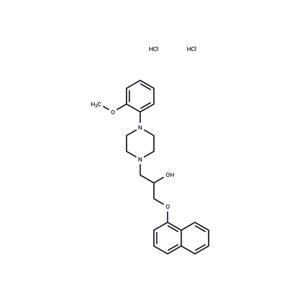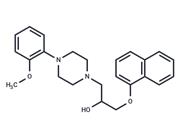| 名称 | Naftopidil dihydrochloride |
| 描述 | Naftopidil dihydrochloride (KT-611 2HCl) is a selective 5-HT1A and α1-adrenergic receptor antagonist with IC50 of 0.1 μM and 0.2 μM, respectively. |
| 细胞实验 | Cell cycle analysis is performed by flow cytometry. Cells are treated with either 20 μM Naftopidil (LNCaP), 40 μM Naftopidil (PC-3) or vehicle (0.1% DMSO) for 24 hours, then trypsinized and washed once with phosphate-buffer saline (PBS), fixed in 70% ethanol and stored at 4 °C for subsequent cell cycle analysis. Fixed cells are washed with PBS and incubated with PBS containing 20 μg/mL RNaseA and 0.3% NP-40 for 30 minutes at 37 °C, then stained with 50 μg/mL propidium iodide (PI) for 30 minutes at 4 癈 in the dark. The DNA content of 1 ?106 stained cells is analyzed on a FACS Caliburflow cytometer. The fractions of cells in the G0/G1, S and G2/M phases are calculated using Cell Quest software.(Only for Reference) |
| 体外活性 | Naftopidil diHCl possesses 5-HT1A agonistic properties in addition to being an α1-adrenoceptor antagonist. [1] Naftopidil has growth inhibitory effect in androgen-sensitive and -insensitive human prostate cancer cell lines. Naftopidil inhibits the growth of androgen-sensitive LNCaP cells and androgen-insensitive PC-3 cells with IC50 of 22.2 μM and 33.2 μM, respectively. Cell growth inhibition by Naftopidil is due to the arrest of the G1 cell cycle. Expressions of p27kip1 and p21cip1 are significantly increased in LNCaP cells treated with Naftopidil. In PC-3 cells, Naftopidil induces p21cip1 but not p27kip1. [2] Naftopidil produces a concentration-dependent inhibition of collagen-induced Ca2+ mobilization, maximum inhibition (22.9%) occurring with 40 μM Naftopidil. The adrenaline-induced rise in [Ca2+]i is inhibited dose dependently by Naftopidil. [3] Naftopidil is significantly more effective than tamsulosin in relieving nocturia. [4] Naftopidil induces G(1) cell-cycle arrest in both PCa cells and PrSC. In Naftopidil-treated PrSC, total interleukin-6 protein is significantly reduced with increased suppression of cell proliferation. [5] |
| 体内活性 | Oral administration of Naftopidil to nude mice inhibits the growth of PC-3 tumors as compared to vehicle-treated controls. Naftopidil improves bladder capacity and relaxed voiding via inhibition of afferent nerve activity. [2] Naftopidil (0.1 μg–30 μg) transiently abolishes isovolumetric rhythmic bladder contraction. The amplitude of bladder contraction is decreased by intrathecal injection of naftopidil (3 μg–30 μg). [6] Naftopidil selectively inhibits the phenylephrine-induced increase in prostatic pressure compared with mean blood pressure in the anesthetized dog model. [7] |
| 存储条件 | Powder: -20°C for 3 years | In solvent: -80°C for 1 year | Shipping with blue ice. |
| 溶解度 | H2O : < 1 mg/mL (insoluble or slightly soluble)
Ethanol : 2 mg/mL (4.29 mM)
DMSO : 39 mg/mL (83.8 mM)
|
| 关键字 | prostate | hyperplasia | pressure | inhibit | Naftopidil dihydrochloride | Naftopidil | Adrenergic Receptor | canine | Naftopidil Dihydrochloride | Beta Receptor | Inhibitor | prostatic | KT 611 | BM 15275 | BM15275 | BM-15275 | KT611 |
| 相关产品 | Alverine citrate | Dapoxetine hydrochloride | CLOZAPINE N-OXIDE | Octopamine hydrochloride | Dexmedetomidine hydrochloride | Trazodone hydrochloride | Mianserin hydrochloride | Cinchonidine |
| 相关库 | 疼痛相关化合物库 | 神经退行性疾病化合物库 | 经典已知活性库 | 膜蛋白靶向化合物库 | 抗癌临床化合物库 | 药物功能重定位化合物库 | 抗癌上市药物库 | 已知活性化合物库 | GPCR靶点分子库 | 抗癌药物库 |

 United States
United States



